Your editor is publishing this multi-country adventure from Daniel Ramsier recounting of his 1,000 kilometer trip in an electric microlight, with some of his outstanding photographs. It’s a truly epic outing that shows ingenuity, great engineering, and a resolute spirit combined to show how much can be accomplished with a very small material involvement. The story highlights Paul MacCready’s advice to do more with much less.
Regardless that it was leisurely journey, averaging 25 kilometers (15.5 miles) per day, it was still a test of Daniel’s hardihood and his craft’s reliability.
Yes, it’s definitely possible to fly and travel “electric”. Taking off from Gruyère (LSGT) in Switzerland on July 15, I arrived in Kyjov in the Czech Republic in 40 days and 22 legs, invited by Marek Wolhard, a paraplegic 3-axis ultralight instructor pilot who had followed @handiflight around the world.
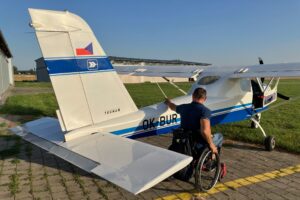
Marek Wolhard with Tecnam two-seater fitted with hand controls
My nano-trike was developed by Ales Hubacek of skyjam-aircraft.com in Zurich. Light and strong, made entirely of titanium, its very low center of gravity makes it very safe to land. 3 batteries of 3.1 kWh each and a 16 kWh motor enable me to fly for 1 hour + 15′ reserve at a speed of 60 km/h. All the electrics come from geigerengineering.de, whose reliability has been recognized for many years. A 150 cm E-prop twin-blade after testing several Helix. My wing, received in June, is the excellent Combat-12T from Aeros.
My luggage includes the chargers (4.5 kg), a small tent under my knees, a sleeping bag and mattress inside the double-surface wing and, in a small bag attached to the back above the parachute, some warm clothes (never used), food and drink for 24 hours, plus cables and chargers for the radio, headphones, camera, iPhone, iPad and a mini laptop. All I needed was a 220 v socket to be completely autonomous.
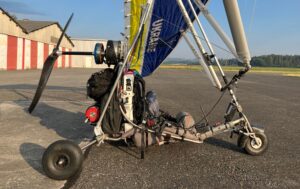
How to pack for a 40-day aerial adventure. Everything includes batteries, charger, personal electronics and a few changes of clothes in a compact arrangement
Without mentioning CO2, the main advantages of electric power that I’ve been experimenting with for over 2 years are reliability due to its simplicity, and silence.
Even though most of the time my wing slept outside (like me) and sometimes in the rain, I never had the slightest breakdown. No spare parts, no consumables and all the tools needed to maintain and repair a combustion engine on a trip. And no worries about fuel quality.
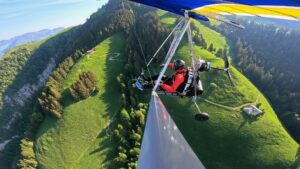
Daniel crossing a mountain ridge while not annoying the residents with engine noise
The other advantage, silence, opens up a whole new flying domain. At 1000 feet/ground (and even lower;-) the noise of the propeller is totally inaudible from the ground, so you can fly at an ideal altitude to enjoy the scenery, at the most beautiful hours of the day, without disturbing anyone.
The only well-known drawback is the range. But this should double in the next few years, thanks to developments in the electrification of the automotive industry.
If we take into account maintenance costs and fuel prices, as for cars, over a 10-year lifespan, the overall cost is comparable to that of combustion engines. And if the initial investment is too high, why not share it between 2 or 3 people?
The highlights of my first trip were crossing Bodensee Lake, the green Bavarian countryside, a few unusual airfields, and fortuitous events such as a concert at Vilshofen airport and the Velke Pavlov costume festival.
But, as always, it’s the encounters that make the greatest impression. And it doesn’t matter whether they’re every 50 or 300 km. Thank you Ulrich, Heike, Vratislav, Vladimir, Pavel. Marek and Paola and see you soon, I look forward to your visit.
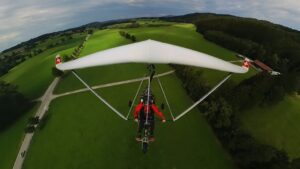
(Editor’s Note: all photos come from Daniel’s Facebook page – much recommended. Click on his name to see the page and some outstanding, dreamlike videos of his flights.

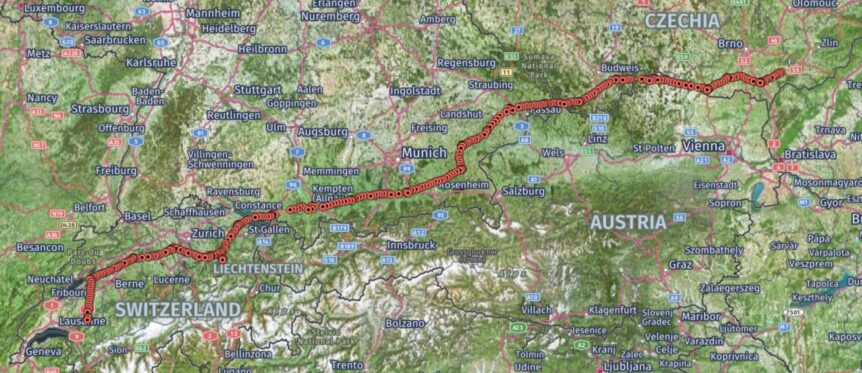
Comments 2
Thank you Dean for your post. In fact the 1000 km were done in 22 legs, so an average of 45 km per leg. I flew 70 km once (with a 45 km/h tailwind).
As always, after meticulous preparation, you just have to dare to take the plunge and be determined, a state of mind I learned from being part of the Solar Impulse team for 6 years.
Author
Daniel,
Thank you for this. It’s heartening to know the blog is read by the people who make it possible. Your videos are outstanding and literally uplifting.